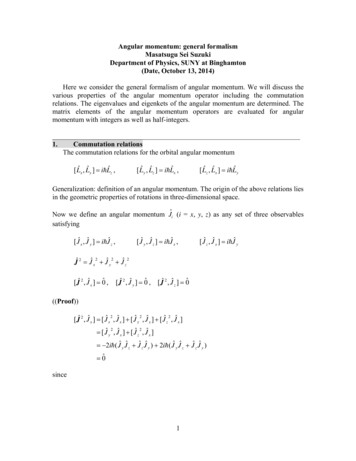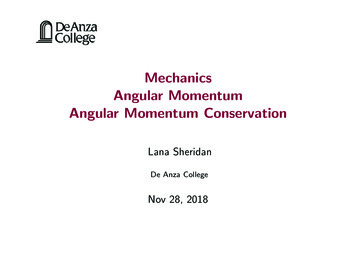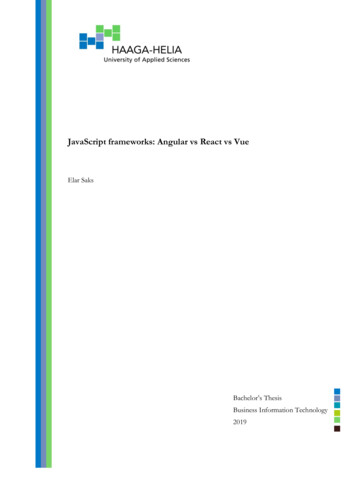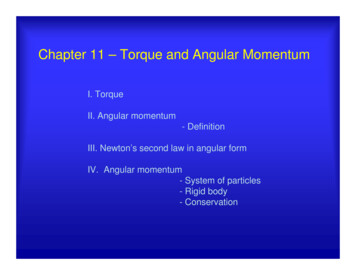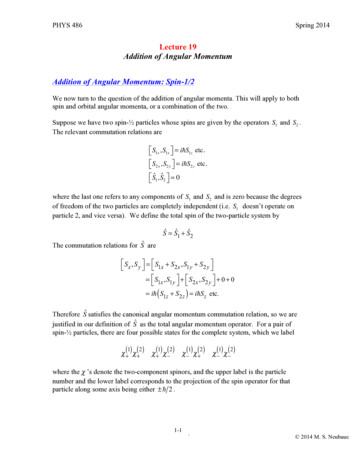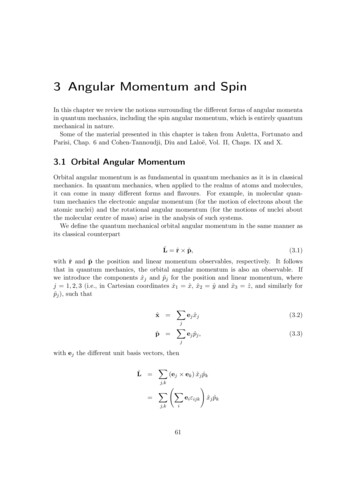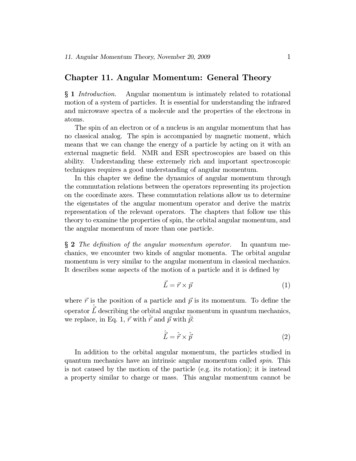
Transcription
11. Angular Momentum Theory, November 20, 20091Chapter 11. Angular Momentum: General Theory§ 1 Introduction. Angular momentum is intimately related to rotationalmotion of a system of particles. It is essential for understanding the infraredand microwave spectra of a molecule and the properties of the electrons inatoms.The spin of an electron or of a nucleus is an angular momentum that hasno classical analog. The spin is accompanied by magnetic moment, whichmeans that we can change the energy of a particle by acting on it with anexternal magnetic field. NMR and ESR spectroscopies are based on thisability. Understanding these extremely rich and important spectroscopictechniques requires a good understanding of angular momentum.In this chapter we define the dynamics of angular momentum throughthe commutation relations between the operators representing its projectionon the coordinate axes. These commutation relations allow us to determinethe eigenstates of the angular momentum operator and derive the matrixrepresentation of the relevant operators. The chapters that follow use thistheory to examine the properties of spin, the orbital angular momentum, andthe angular momentum of more than one particle.§ 2 The definition of the angular momentum operator. In quantum mechanics, we encounter two kinds of angular momenta. The orbital angularmomentum is very similar to the angular momentum in classical mechanics.It describes some aspects of the motion of a particle and it is defined byL r p(1)where r is the position of a particle and p is its momentum. To define theˆoperator L describing the orbital angular momentum in quantum mechanics,ˆwe replace, in Eq. 1, r with ˆr and p with p:ˆL ˆr pˆ(2)In addition to the orbital angular momentum, the particles studied inquantum mechanics have an intrinsic angular momentum called spin. Thisis not caused by the motion of the particle (e.g. its rotation); it is insteada property similar to charge or mass. This angular momentum cannot be
11. Angular Momentum Theory, November 20, 20092defined by Eq. 2. Born, Heisenberg, and Jordan1 noted that the angularmomentum defined by Eq. 2 satisfies the commutation relations[L̂x , L̂y ] ih̄L̂z(3)[L̂y , L̂z ] ih̄L̂x(4)[L̂z , L̂x ] ih̄L̂y(5)We take this to be a definition: a vector operator whose components satisfyEqs. 3—5 is an angular momentum. This definition is valid for both theorbital angular momentum and the spin. A compact way of writing theseexpressions, using the Levi-Civitta tensor, is explained in Appendix A11.1. Inthis chapter we will use often a variety of expressions involving commutators;Appendix A11.2 reviews the definition and derives several useful facts.§ 3 L̂2 commutes with L̂x , L̂y , and L̂z . We know from classical mechanicsthat the rotational energy is proportional to the square of the angular momentum vector. Since this is an important quantity, we are naturally led toexamine the operatorL̂2 L̂2x L̂2y L̂2z(6)This operator commutes with L̂x , L̂y , and L̂z .We start with[L̂z , L̂2 ] [L̂z , L̂2x ] [L̂z , L̂2y ] [L̂z , L̂2z ](7)Any operator commutes with a power of itself, so[L̂z , L̂2z ] 0(8)To calculate [L̂2x , L̂z ], we use the relationship, derived in Appendix A11.2(Eq. 160),[Â, B̂ 2 ] [Â, B̂]B̂ B̂[Â, B̂],giving us[L̂z , L̂2x ] [L̂z , L̂x ]L̂x L̂x [L̂z , L̂x ],1(9)M. Born, W. Heisenberg, and P. Jordan, Zur Quantenmechanik II, Zeitschrift fürPhysik 35 (8—9), 557-615 (published August 1926; received November 16, 1925). Englishtranslation in: B. L. van der Waerden, editor, Sources of Quantum Mechanics (DoverPublications, 1968, ISBN 0-486-61881-1).
11. Angular Momentum Theory, November 20, 20093followed by Eq. 5, to obtain[L̂z , L̂2x ] ih̄L̂y L̂x ih̄L̂x L̂y ih̄ L̂y L̂x L̂x L̂y(10)You can show similarly that[L̂z , L̂2y ] ih̄ L̂y L̂x L̂x L̂y(11)Using Eqs. 8—11 in Eq. 7 gives[L̂2 , L̂z ] 0(12)In the same way, you can show that[L̂2 , L̂x ] 0(13)[L̂2 , L̂y ] 0(14)andCommon sense tells us that if Eq. 12 is true, then Eqs. 13 and 14 must alsobe true, because there is no physical agent that differentiates between theOZ and OX or OY directions.§ 4 The eigenstates of L̂2 and L̂z . Since L̂2 commutes with L̂z , there existsa set of eigenfunctions of L̂2 that are also eigenfunctions of L̂z . Because L̂zdoes not commute with L̂x or with L̂y , a joint eigenstate of L̂2 and L̂z cannotbe an eigenstate of L̂y or of L̂z .Let us examine in more detail what this means. Since L̂2 and L̂z commute,there exists a set of kets Lz ; α, β that satisfy the eigenvalue equations forthose two operators:L̂2 Lz ; α, βL̂z Lz ; α, β α Lz ; α, β β Lz ; α, β(15)(16)α is the value that L2 can have in a measurement. It is therefore relatedto the rotational energy. β is the value that the projection of the angularmomentum on the Z-axis can take. The symbol Lz inside the ket reminds usthat this is an eigenket of L̂z , not of L̂x or L̂y .But L̂2 also commutes with L̂x , so there must exist a set of kets Lx ; α, βsuch thatL̂2 Lx ; α, βL̂x Lx ; α, β α Lx ; α, β β Lx ; α, β(17)(18)
11. Angular Momentum Theory, November 20, 20094As long as no electric or magnetic field acts on the system there is no physicaldifference between the OX and the OZ axes. Therefore, the values that βcan take in Lx ; α, β are the same as the values it can take in Lz ; α, β .In what follows, we concentrate on the joint eigenstates of L̂2 and L̂z . Atthis point there is no reason to prefer L̂z over L̂x or L̂y .Suppose that we have performed an experiment that places the systemin the state Lz ; α, β . We can measure L2 and get the value α, or we canmeasure Lz and get the value β. However, if we measure Lx , when the systemis in state Lz ; α, β , we find Lx to be β with the probability Lx ; α, β Lz ; α, β 2When the system is in the state Lz ; α, β , we know L2 and Lz with certaintybut we only know the probability that Lx takes a given value. For someonefamiliar with quantum mechanics, this is not surprising. L̂z and L̂x do notcommute so the eigenstate Lz ; α, β cannot be an eigenstate of L̂x .These results are incomprehensible within classical physics, where thereis no physical law to prevent us from knowing with certainty all three projections of any vector once we know the state of the system (i.e. the valuesof the position and of the momentum).§ 5 L̂2 and L̂z commute with other operators. One difficulty in graspingthe physics of angular momentum comes from the fact that in many concrete problems, L̂x , L̂y , and L̂z are not the only operators describing thesystem. For example, we might examine two particles interacting through acentral force. This means that the potential energy V (r) depends only onthe distance r between the particles and is independent of their orientationin space. You know two examples of such systems: the hydrogen atom andthe diatomic molecule.The eigenvalue problem for the Hamiltonian of the hydrogen atom is (seeMetiu, Quantum Mechanics, p. 206) ψh̄2 1 r222μ r r r L̂2ψ V (r)ψ Eψ2μr2(19)We see that besides the angular momentum squared L̂2 , the equation contains the potential energy V (r) and the radial kinetic energy (the first term).You have also learned that the Hamiltonian Ĥ of the hydrogen atom commutes with L̂2 and with L̂z . This means that Ĥ, L̂2 , and L̂z have common
11. Angular Momentum Theory, November 20, 20095eigenstates, denoted by n, j, m . In the state n, j, m , the energy of theatom is (see Metiu, p. 300)En μe2 z 212 2,22(4π 0 ) h̄ n(20)the square of the angular momentum ish̄2 j(j 1),(21)and the projection of the angular momentum on the z-axis ish̄m(22)1μe2 z 2 n, j, m22(4π 0 )2h̄ n2(23)In other words, we haveĤ n, j, m L̂2 n, j, m h̄2 j(j 1) n, j, mL̂z n, j, m h̄m n, j, m(24)(25)Here j indicates the eigenvalue of L̂2 and m indicates the eigenvalue of L̂z .We learn from this example that the eigenstates of L̂2 and L̂z may also beeigenstates of other observables that commute with L̂2 and L̂z (in this case,the energy). These eigenstates are labeled by additional quantum numbers(n, in this case); they are n, j, m , not just j, m .A similar situation appears in the case of the diatomic molecules. If wemake the rigid-rotor approximation and the harmonic approximation, theeigenvalue equation for the energy, Eq. 19 becomes (see Metiu, Chapter 16) ψh̄2 1 r222μ r r r L̂21ψ k(r r0 )2 ψ Eψ22μr02(26)The eigenstates are ψ v, j, m , in which the molecule has the vibrationalenergy1(27)Ev h̄ω v 2and the values of L̂2 and L̂z given by Eqs. 21 and 22. Eqs. 24 and 25 holdfor this example also.
11. Angular Momentum Theory, November 20, 20096In general, when L̂2 and L̂z commute with other operators, their eigenstates must be eigenstates of those operators. When we need to make thisexplicit, these eigenstates will be labeled a, j, m , where a tells us the valuethat the quantities represented by these other operators takes, when thesystem is in a pure state a, j, m and a measurement is made.§ 6 A more convenient notation. I now change notation by writingα h̄2 j(j 1)β h̄m Lz ; α, β Lz ; j, m(28)(29)(30)The eigenvalue equations Eqs. 15 and 16 becomeL̂2 Lz ; j, m h̄2 j(j 1) Lz ; j, m(31)L̂z Lz ; j, m h̄m Lz ; j, m(32)α 0(33)andSetting α h̄2 j(j 1) needs further examination. We must havebecause α is a value that L2 can take. It is a minor complication that theequation α h̄2 j(j 1) has two solutions for j:j1 11 21 4α/h̄2(34)and1 1 1 4α/h̄2(35)2Because α/h̄2 0, both roots j1 and j2 are real, j1 is negative, and j2 is nonnegative. Remember that α is a physical observable while j is an arbitrarymathematical quantity introduced for convenience. You can verify that thenegative values of j give the same values of α as the non-negative ones. Wecan choose either for indexing the kets, and we choosej2 j 0(36)Note also that m must be a real number (h̄m is a value of Lz ). BecauseLz is equally likely to be positive or negative, we expect m to be able to take
11. Angular Momentum Theory, November 20, 20097both positive and negative values. Moreover, we guess that if m is an allowedvalue, then m is also allowed since the projection of the angular momentumvector on the OZ axis can be oriented along OZ (m 0) or opposite to it(m 0).§ 7 A summary of our task.we need to do the following.To set up the theory of angular momentum,1. Since most calculations in quantum mechanics are done by representingoperators by matrices, we need to use the kets Lz ; j, m as a basis setand find out how to calculate the matrix elements Lz ; j, m Ô Lz ; j , mfor Ô L̂x and L̂y .2. Find the values of j and m allowed by the eigenvalue equations Eqs. 31—32.To reach these objectives, we only have the commutation relations Eqs. 3—5 and our wits. The strategy is simple but tedious. We know how L̂2 andL̂z act on Lz ; j, m . Therefore we must use the commutation relations toexpress L̂x and L̂y in terms of L̂2 and L̂z . Determining the allowed values ofj and m is more subtle and cannot be reduced to a few sentences.§ 8 The ladder operators. In vector calculus, one often describes a vector{vx , vy , vz } through its spherical components {vx ivy , vx ivy , vz }. It mighttherefore be useful to take a look at the operatorsL̂ L̂x iL̂y(37)L̂ L̂x iL̂y(38)andalong with L̂z and L̂2 . If we find out how L̂ and L̂ act on Lz ; j, m , thenit is easy to useL̂ L̂ L̂x (39)2andL̂ L̂ (40)L̂y 2ito find out how L̂x and L̂y act on Lz ; j, m . Working with L̂ and L̂ willprove to be fruitful.
11. Angular Momentum Theory, November 20, 20098Our strategy relies on commutation relations and I derive here all thecommutations relations that we need. The commutators of L̂ and L̂ withL̂2 and L̂z are easily derived from the definitions, Eqs. 37 and 38, and theoriginal commutation relations, Eqs. 3—5. They are[L̂z , L̂ ] h̄L̂ (41)[L̂z , L̂ ] h̄L̂ (42)[L̂2 , L̂ ] [L̂2 , L̂ ] 0(43)andWe also havebecause L̂2 commutes with both L̂x and L̂y , hence with both L̂ and L̂ .To carry out our program of determining what happens when L̂ and L̂ act on Lz ; j, m , we need to find expressions that contain L̂ and/or L̂ inthe left-hand side and only L̂z and L̂2 in the right-hand side. I derive belowseveral such expressions. One of them isL̂ L̂ (L̂x iL̂y )(L̂x iL̂y ) (used Eqs. 37&38) L̂2x L̂2y i(L̂x L̂y L̂y L̂x ) L̂2x L̂2y i[L̂x , L̂y ] L̂2x L̂2y i2 h̄L̂z (used Eq. 3) L̂2 L̂2z h̄L̂z (used L̂2 L̂2x L̂2y L̂2z )(44)SimilarlyL̂ L̂ L̂2 L̂2z h̄L̂z(45)L̂ L̂ L̂ L̂ L̂2 L̂2z2(46)L̂† L̂ (47)L̂† L̂ (48)L̂† L̂ L̂† L̂ L̂2 L̂2z2(49)We can add Eqs. 44 and 45 to obtainUsingandwe can rewrite Eq. 46 as
11. Angular Momentum Theory, November 20, 20099For notational§ 9 Find expressions for L̂ Lz ; j, m and L̂ Lz ; j, m .convenience, I will drop the marker Lz from the eigenkets Lz ; j, m andreinstate it only when there is some possibility of confusion.The fact that L̂2 and L̂ commute leads toL̂2 L̂ j, m L̂ L̂2 j, m h̄2 j(j 1)L̂ j, m(50)This equation tells us that if j, m is an eigenstate of L̂2 with the eigenvalueh̄2 j(j 1) then L̂ j, m is also an eigenstate of L̂2 , with the same eigenvalueh̄2 j(j 1).Since [L̂z , L̂ ] h̄L̂ (Eq. 41), we haveL̂z L̂ L̂ L̂z j, m h̄L̂ j, m(51)Use L̂z j, m h̄m j, m in the left-hand side and rearrange the terms:L̂z L̂ j, m h̄(m 1) L̂ j, m(52)Eq. 52 tells us that L̂ j, m is either zero, which is uninteresting, or it is aneigenstate of L̂z with the eigenvalue h̄(m 1). This means thatL̂ j, m C (j, m) j, m 1(53)where C (j, m) is a number that may or may not depend on j and m.Note that in Eq. 53, L̂ acts on j, m and does not affect the value of jbut changes m. This is in agreement with Eq. 50, which says that L̂ j, mis an eigenfunction of L̂2 with the eigenvalue h̄2 j(j 1).A similar argument starts from [L̂z , L̂ ] h̄L̂ (Eq. refeq11:3.11.4) andconcludes that(54)L̂ j, m C (j, m) j, m 1where C (j, m) is another, unknown constant. Also, L̂ j, m is an eigenfunction of L̂2 corresponding to the eigenvalue h̄2 j(j 1).The operators L̂ and L̂ are called ladder operators; L̂ is called a raisingoperator and L̂ , a lowering operator. When L̂ acts on j, m , it increasesm by 1 and multiplies the result by C (j, m); when L̂ acts on j, m , itdecreases m by 1 and multiplies the result by C (j, m). The operators L̂ and L̂ do not affect j in j, m , because both L̂ and L̂ commute with L̂2and therefore they have common eigenstates with L̂2 . In other words, theymust convert a state in which L̂2 has the value h̄2 j(j 1) into a state inwhich L̂2 has the same value h̄2 j(j 1).
11. Angular Momentum Theory, November 20, 200910To determine C (j, m) or§ 10 The constants C (j, m) and C (j, m).C (j, m), we need to derive first a few helpful results. Consider λ  x(55)where x is an arbitrary ket and  is an arbitrary operator. We haveλ λ Âx Âx x †  x(56)I used here the property Âx z x † z of adjoint operators ( x and zare arbitrary kets).In addition, if x a y(57)where a is a number, thenλ λ ay ay a a y y(58)Let us use Eqs. 56 and 58 to determine C . To do this I apply Eq. 56 to λ L̂ j, m(59)λ λ j, m L̂† L̂ j, m(60)λ L̂ j, m C j, m 1(61)and obtainWe also haveNow apply Eq. 58 to getλ λ C C j, m 1 j, m 1 C C (62)I used the fact that j, m 1 j, m 1 1 (or, if j, m 1 is zero, then sois C ). The two expressions for λ λ must be equal and thereforej, m L̂† L̂ j, m C C (63)I am very pleased with this equation, for two reasons. First, I obtaineda formula for C . Second, this equation contains L̂ L̂ , which, according toEq. 44 isL̂ L̂ L̂2 L̂2z h̄L̂z
11. Angular Momentum Theory, November 20, 200911This expresses L̂ L̂ in terms of L̂2 and L̂z . I know how L̂2 and L̂z act on j, m and therefore I can readily calculate the matrix element in Eq. 63.Eq. 63 determines the absolute value of C but not its phase. Since allphysical properties of a ket are independent of a phase factor in front of it,I can take in C any phase I want. I choose it so thatj, m L̂† L̂ j, m(64)j, m L̂2 L̂2z h̄L̂z j, m(65)C (j, m) Now use Eq. 44 in Eq. 64:C (j, m) Using the eigenvalue equations for L̂2 and L̂z (Eqs. 31—32), we rewrite Eq. 65asC (j, m) h̄ j(j 1) m(m 1)(66)(we used j, m j, m 1).Finally, putting C (j, m) given by Eq. 66 into Eq. 53 givesL̂ j, m h̄ j(j 1) m(m 1) j, m 1(67)Note that L̂ j, m is an eigenstate of L̂2 corresponding to the eigenvalueh̄j(j 1) and an eigenstate of L̂z corresponding to the eigenvalue (m 1)h̄.However, j, m is not an eigenstate of L̂ . It should not be, because L̂ does not commute with L̂2 or with L̂z .To calculate C (j, m), we follow the reasoning used to find C (j, m). Thisleads to(68)C (j, m) h̄ j(j 1) m(m 1)andL̂ j, m h̄ j(j 1) m(m 1) j, m 1(69)We can now calculate (use Eqs. 66, 69, 39)L̂x j, m1(L̂ L̂ ) j, m21 [C (j, m) j, m 1 C (j, m) j, m 1 ]2 (70)Similarly (use Eqs. 66, 69, 40)L̂y j, m 1[C (j, m) j, m 1 C (j, m) j, m 1 ]2i(71)
11. Angular Momentum Theory, November 20, 200912§ 11 The matrix elements of L̂ , L̂ , L̂x , L̂y in the basis set j, m . Nowthat we know how L̂ and L̂ act on j, m (Eqs. 67 and 69), we can calculatethe matrix elementsj , m L̂ j, m h̄ j(j 1) m(m 1) j , m j, m 1 h̄ j(j 1) m(m 1) δj I j δmI ,m 1(72)The only non-zero matrix elements are those for which m m 1 and j j.Therefore onlyj, m 1 L̂ j, m h̄ j(j 1) m(m 1)(73)differs from zero.The matrix elements of L̂ arej , m L̂ j, m h̄ j(j 1) m(m 1) δj I j δmI ,m 1(74)j, m 1 L̂ j, m h̄ j(j 1) m(m 1)(75)and onlydiffers from zero.Since (see Eq. 39)L̂x L̂ L̂ 2we havej , m L̂x j, m h̄(C (j, m) δj I j δmI ,m 1 C (j, m) δj I j δmI ,m 1 )2(76)Only the matrix elementsj, m 1 L̂x j, m h̄C (j, m)2(77)j, m 1 L̂x j, m h̄C (j, m)2(78)anddiffer from zero.Using (see Eq. 40)L̂y L̂ L̂ 2i
11. Angular Momentum Theory, November 20, 200913with Eqs. 72 and 74 leads toj , m L̂y j, m h̄(C (j, m) δj I j δmI ,m 1 C (j, m) δj I j δmI ,m 1 )2i(79)Only the matrix elementsj, m 1 L̂y j, m andh̄C (j, m)2ih̄j, m 1 L̂y j, m C (j, m)2i(80)(81)differ from zero.This covers all the matrix elements used in applications. However, westill don’t know what values j and m can take, since we do not know theeigenvalues of L̂2 and L̂z . Next, we start working to find them.The values of j and mWe have decided to use the eigenstates j, m of L̂2 and L̂z as a basis setfor other operators relevant to angular momentum, and we have managedto calculate their matrix elements. The remaining task is to determine theallowed values of j and m.§ 12 For a given j, m has a highest and a lowest value. A classical interpretation of angular momentum tells us that if L̂2 is fixed then L̂z must havean upper and a lower bound. Indeed the projection of a vector on an axiscan at most be equal to the length of the vector: the projection has theupper bound and the lower bound . Since quantum mechanics is notclassical mechanics, it will be reassuring to prove that, for a given j, m hasan upper and a lower bound.Recall that (Eqs. 46 and 49)andL̂ L̂ L̂ L̂ L̂2 L̂2z2(82)L̂† L̂ L̂† L̂ L̂2 L̂2z2(83)
11. Angular Momentum Theory, November 20, 200914From properties of the inner product, we know that for any ket x andany operator Â, we have x †  x 0 (with equality only when  x 0).Taking the matrix element of the operator in Eq. 83 with the non-zero ket j, m givesj, m L̂† L̂ j, m j, m L̂† L̂ j, m 2h̄2 (j(j 1) m2 )(84)Since the left-hand side cannot be negative, we conclude thatj(j 1) m2 0(85)This means that if j is fixed then m has both a lower bound and an upperbound. We don’t know what the bounds are but we know that they exist, solet us denote them by m and mu .This gives us two new equations to play with:L̂ j, muL̂ j, m 0 0(86)(87)To derive them, observe that, according to Eq. 53, L̂ j, mu C (j, mu ) j, mu 1 . Since no value of m can be larger than mu , the state j, mu 1 cannot exist and the ket is zero (which proves Eq. 86). One arrives at Eq. 87similarly.Now let us act with L̂ on Eq. 86 and with L̂ on Eq. 87, to obtainL̂ L̂ j, muL̂ L̂ j, m 0 0(88)(89)Why do I do that? Because we know that (Eq. 44)L̂ L̂ L̂2 L̂2z h̄L̂z ;the right-hand side of this equation contains only operators that act on j, maccording to known rules, which means that we can calculate0 L̂ L̂ j, m (L̂2 L̂2z h̄L̂z ) j, m (h̄2 j(j 1) h̄2 m2u h̄2 mu ) j, mu(90)This implies thatj(j 1) m2u mu 0(91)
11. Angular Momentum Theory, November 20, 200915Similarly, using (see Eq. 45)L̂ L̂ L̂2 L̂2z h̄L̂zin Eq. 89 givesj(j 1) m2 m 0(92)Solving Eq. 92 for j(j 1) and using the result in Eq. 91 givesmu (mu 1) m (m 1)(93)This equation has two solutionsmu m(94)mu m 1(95)andThe second root is excluded by the fact that mu m by definition.We see therefore that mu m . Symmetry requires the possible projections of L̂ along OZ to be equal to and of opposite sign to the possibleprojections in the direction opposite to OZ. Eq. 94 agrees with this requirement.§ 13 The values of m and j. We have learned a lot but we still don’t knowwhich values j and m can take. Here we settle this question.Let us consider a ket j, m0 where m0 is an allowed value of m for thegiven j. Acting on that ket with L̂ repeatedly, we obtainL̂ j, m0 C (j, m0 ) j, m0 1 ,L̂2 j, m0 C (j, m0 )C (j, m0 1) j, m0 2 ,etc. After some number nu of steps, this procedure must generate a ketproportional to j, mu . If it did not, then we could apply L̂ indefinitely,which contradicts the fact that m has a largest value, namely mu . Thereforewe must havemu m0 nu(96)where nu is a non-negative integer. Similarly, applying L̂ to j, m0 some ntimes produces a ket proportional to j, m , so thatm m0 n(97)
11. Angular Momentum Theory, November 20, 200916with n a non-negative integer. From Eqs. 96 and 97, it follows thatmu m (m0 nu ) (m0 n ) nu n n(98)where n is a non-negative integer. Since we already know that mu m(Eq. 94), we conclude that(99)2mu nWe also know that (see Eq. 91)j(j 1) m2u mu mu (mu 1)(100)This has two solutionsj mu(101)j mu 1(102)andEq. 102 is not compatible with the facts that mu 0 and j 0, so we caneliminate it as irrelevant.Now combining mu n/2 (Eq. 99) with Eq. 101 givesj n2(103)We have obtained a startling result: j can be either a non-negative integer(if n is even) or a half-integer (if n is odd). In addition, the largest value ofm is j and (since m mu ) the smallest value of m is j. Therefore mcan take the 2j 1 values j, j 1,. . . , j 1, j.The theory of orbital angular momentum (see Metiu, Chapter 14, p. 220ff),based on the equation L r p, tells us that half-integer values of j are notallowed for orbital angular momentum. However, by using the commutationrelations to define the angular momentum, we have found that j can be either integer or half-integer. We know of no additional condition that we canuse to conclude that half-integers are not allowed in general. Therefore thepostulate that the electron has an intrinsic angular momentum (the spin)with j 1/2 is in harmony with conclusions derived from the commutationrelations.§ 14 Summary. This lengthy derivation led us to the following results. L̂2and L̂z have common eigenstates L̂z ; j, m for whichL̂2 L̂z ; j, m h̄2 j(j 1) L̂z ; j, m(104)
11. Angular Momentum Theory, November 20, 200917andL̂z L̂z ; j, m h̄m L̂z ; j, m .(105)m j, j 1, j 2, . . . , j 2, j 1, j(106)j can be either a non-negative integer or a positive half-integer (that is, ofthe form integer/2). m can take 2j 1 discrete valuesFor example, if j 32then m can take 2 32 1 4 values, namely333331 1 3m , 1, 1, , , ,222222 2 2If j 3 then m takes the 2 3 1 7 values 3, 2, 1, 0, 1, 2, 3.We have also found that1L̂x L̂z ; j, m [C (j, m) L̂z ; j, m 1 C (j, m) L̂z ; j, m 1 ]2and1L̂y L̂z ; j, m [C (j, m) L̂z ; j, m 1 C (j, m) L̂z ; j, m 1 ]2iwithC (j, m) h̄ j(j 1) m(m 1)(107)(108)(109)andC (j, m) h̄ j(j 1) m(m 1).(110)Note that j, m 0 if m [ j, j].The matrix elements needed in computations areL̂z ; j , m L̂z L̂z ; j, mL̂z ; j , m L̂2 L̂z ; j, mL̂z ; j , m L̂x L̂z ; j, mL̂z ; j , m L̂y L̂z ; j, m δjj I δmmI h̄m(111) δjj I δmmI h̄2 j(j 1)(112)C (j, m)δmI ,m 1 C (j, m)δmI ,m 1 δjj I(113)2C (j, m)δmI ,m 1 C (j, m)δmI ,m 1 δjj I(114)2iNote that all these matrix elements are zero if j j . This means thatin the basis set L̂z ; j, m , the matrices of L̂x and L̂y consist of smallermatrices strung along the diagonal; there are no non-zero matrix elementsj, m Ôj , m in which j j if Ô L̂x , L̂y , L̂ , or L̂ or any function ofthem.
1811. Angular Momentum Theory, November 20, 2009The eigenvalue problems for angular momentum operators§ 15 Introduction. We have seen several times that kets are very useful fortheoretical analysis, but practical calculations often use the representation ofkets by vectors and of operators by matrices. In this section I review brieflythe general theory and then apply it to the case of j 3 as an example.Let us assume that on physical grounds we have decided that a certainphysical system can be described by a ket space generated by the orthonormalbasis set η1 , η2 , . . . , ηN . An arbitrary state ψ is then represented asN ψ N ηi ηi ψ i 1i 1 ηi ci(115)and an arbitrary operator Ô byNNÔ i 1 k 1N ηi ηi Ô ηk ηk Ni 1 k 1 ηi Oik ηk (116)Since we are assumed to know ηi , i 1, 2, . . . , N , knowing the vectorψ {c1 , c2 , . . . , cN }(117)is equivalent to knowing ψ (because of Eq. 115). Eq. 116 tells us that weknow how to operate with Ô if we know the matrix elementsOik ηi Ô ηk(118)The basis set kets ηi are represented by the vectors η1 {1, 0, . . . , 0} .ηNand therefore {0, 0, . . . , 1} (119)Nψ ci ηi(120)i 1The eigenvalue problem Ô ψ o ψ is represented by the eigenvalue problemfor the matrix OOik ck o ci ,k
1911. Angular Momentum Theory, November 20, 2009which in vector-and-matrix notation is written asOψ oψor O11 . . .ON 1 (121) · · · O1Nc1 . . o . . · · · ON NcNThe solution of Eq. 122 provides N eigenvectors c1. . (122)cNψ(α) {c1 (α), . . . , cN (α)}, α 1, . . . , N(123)and N eigenvalues o(1), . . . , o(N ).From these we can calculate the N eigenkets ψ(1) , . . . , ψ(N ) by usingN ψ(α) ck (α) ηk , α 1, 2, . . . , N(124)k 1§ 16 The matrix-and-vector representation for angular momentum problems.It is natural to use for angular momentum calculations the basis set j, m .In this basis set, the matrix elements of L̂z , L̂2 , L̂x , and L̂y are given byEqs. 111—114. When looking at these equations, we notice that all matrixelements in which j j are zero. The matrices of the operators L̂2 , L̂z , L̂x ,and L̂y are therefore block diagonal: . All matrix elements other than the dots are zero.We have labeled the rows and the columns in the following order:
2011. Angular Momentum Theory, November 20, 2009 j 0, m 0 j 1, m 1 j 1, m 0 j 1, m 1 etc.The state with j 0 generates a 1 1 block, the states with j 1 generatea 3 3 block, . . . ; in general, the states having an arbitrary j generate a(2j 1) (2j 1) block. This break-up into blocks makes this basis setparticularly simple to use in calculations. Physically it signifies that stateswith different values of j are not coupled by any of the operators L̂2 , L̂z , L̂x ,and L̂y .Because of this “block” property, we can treat physical problems involvinga specific j within a reduced space generated by the basis set j, j , j, j 1 , . . . , j, j 1 , j, j(125)§ 17 The case j 1. Let us solve some problems for j 1. The basis setis 1, 1 , 1, 0 , 1, 1(126)Since we know that j 1, the first index is superfluous and we use insteadthe notation 1 , 0 , 1 . The matrix representing an operator Ô in thissubspace is 1 Ô 1 O 0 Ô 11 Ô 1 1 Ô 00 Ô 01 Ô 0 1 Ô 1 0 Ô 1 1 Ô 1(127)A look at Eqs. 111 and 112 tells us that the matrix elements 1, m L̂2 1, mand 1, m L̂z 1, m are zero if m m . Therefore the corresponding matrices are diagonal: 1 0 0 L2 h̄2 (1)(1 1) 0 1 0 (128)0 0 1
11. Angular Momentum Theory, November 20, 2009and h̄ 0 0 Lz 0 0 0 0 0 h̄21(129)No surprise here. The basis set consists of eigenstates j, m of L̂2 and L̂zand therefore the matrices of these operators, in that basis set, are diagonaland the diagonal elements are the eigenvalues of the operator.The matrices corresponding to L̂x and L̂y are more interesting. Let uslook at L̂x , and use Eq. 113 together with Eqs. 109 and 110. I calculate, asan example, 1 L̂x 1 . We havem 1 L̂x m 1 0(130)because (see Eq. 113)δmI ,m 1 δ 1, 1 1 δ 1,0 0andδmI ,m 1 δ 1, 1 1 δ 1, 2 0Another example is (use Eq. 113)m 1 L̂x m 0 withC (1, 0)δ 1,0 1 C (1, 0)δ 1,0 1C (1, 0) 22(131) C (1, 0) h̄ 1(1 1) 0(0 1) h̄ 2(132)Together these giveh̄ 1 L̂x 0 2(133)Patiently calculating all the matrix elements leads to2 Lx 0 h̄20 h̄20 h̄20 h̄20 (134)The top row is mI 1, the middle row is mI 0, and the bottom row is mI 1;the left column is m 1, the middle column is m 0, and t
§ 2 The definition of the angular momentum operator. In quantum me-chanics, we encounter two kinds of angular momenta. The orbital angular momentum is very similar to the angular momentum in classical mechanics. It describes some aspects of the motion of a particle and it is defined by nL nr np (1)

